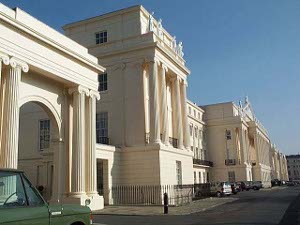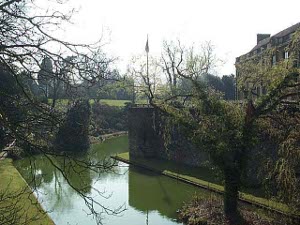 Cumberland Terrace
Cumberland Terrace
The elegant mansions of Cumberland Terrace face Regent's Park, one of the largest, and certainly one of the most pleasant, of London's parks. George IV owned the land, and his favorite architect John Nash drew up the plans. The terrace buildings surrounding much of the park were built over 160 years ago, but still seem stylish and elegant. And the whole shebang is still owned by the Crown. The little signs reading C.E.P.C. stand for Crown Estate Paving Commission, which does the maintenance. Our flat in Cumberland Terrace Mews, in the rear, was used for coachmen and the like!
 Cumberland Terrace
Cumberland Terrace
The weather in London has turned gorgeous. Spring is here, with temperatures around sixty and flowers everywhere, and Londoners are out with their families. We took a Saturday afternoon walk through Regent's Park, which was filled, but not crowded, with people. Starting down Broad Walk, we passed the Zoo, started in 1828, when the original zoo-keeper, according to Michelin, wore "a top hat, bottle green coat and striped waistcoat". It is surely a perfect description of Dr. Doolittle!
There are signs everywhere in London, often historical, frequently pleading with the citizenry to observe good habits (which they mostly do except when drunk). One sign talked about how the turf in the park gets worn out from sports, and what government was doing, etc. Despite the sign, we counted 14 soccer fields (oops, sorry, football fields) occupied with serious teams, often in some semblance of uniforms, many wearing nobbed shoes, all of them (it seemed to us) good, gradually chewing up the turf. There did seem to be some segregation: one game had all black players, another all Japanese. The fields ranged from those completely equipped with goals and nets to others simply marked off with white lines. Oddly, we didn't see any officials; evidently the players policed themselves. In between the games were little kids kicking the balls and mothers with carriages. The huge London Mosque is visible from the park, and we noticed a significant number of Islamic women, some head to toe in black, with only a slit for the eyes.
Beyond the playing fields are boating ponds, one for little children in paddle boats (3 pounds a ride, and if they don't paddle back to shore a  A wedding in Regent's Park
teenager in waders tows them in) and one for bigger boaters, sharing the water with ducks, swans, geese and herons. There's an island in the middle where nests have been rigged for the herons, and the birds gave us additional confirmation that Spring has arrived.
A wedding in Regent's Park
teenager in waders tows them in) and one for bigger boaters, sharing the water with ducks, swans, geese and herons. There's an island in the middle where nests have been rigged for the herons, and the birds gave us additional confirmation that Spring has arrived.
We crossed a bridge to Queen Mary's garden, past Regent's College -- "an American liberal arts college." The roses are leafing out, but no blooms yet. Inside the central circle the sounds of drums and chanting caught our ear. It was an African style wedding party. Michelin gives Regent Park three stars. It's not so much for the attractions, we decided, as for the park's general beauty and utility. Few cities we've visited have parks as lovely, or as well used, as London.
The next day we felt proud that we walked to Camden Town, took the underground to Charing Cross, bought our senior discount day return tickets to the suburb of Eltham (two pounds each), and walked from the Eltham station half a mile through town to Eltham Palace. We're getting to be quite competent at maneuvering around London.
Eltham is an ordinary Kentish suburban town, with ordinary high street stores, including a McDonalds in a former bank building, so it was quite a shock to walk another hundred yards to a bridge over a moat to a building on an estate used by William the Conqueror.
Prior to 1086, the manor of Eltham belonged to Edward the Confessor. Then it passed to William's half-brother, the Bishop of Bayeux. Henry III  Moat around Eltham Palace
spent Christmas at Eltham, and the Bishop of Durham aquired the estate and built a new moated manor house in 1295. Geoffrey Chaucer was employed at Eltham as Clerk of the Works in 1300. In 1311 Eltham became a Royal House, and was granted by Edward III to his Queen, Isabella. He held a tournament there in 1347. In 1397 the French King and Queen spent Christmas at Eltham with Richard II. Henry IV spent lavishly on Eltham, and entertained the Byzantine Emperor in 1400. The Great Hall, still standing, was completed by Edward IV in 1483. (It was almost lost to a firebomb in World War II, but quick action saved it.) Henry VIII grew up in Eltham, and an elaborate Twelfth Night performance was staged for him in 1515. Henry VIII had it modernized, Elizabeth I had her chamber rebuilt, but finally James I lost interest in the property, paying his last visit in 1612. In 1649 Eltham was surveyed and found untenantable, and in 1651 sold to Colonel Nathaniel Rich, who commenced its demolition. Fortunately he did not demolish the Great Hall, but the building fell into further disrepair, being used as a barn. In the nineteenth and twentieth centuries government funds were spent to repair the building, until finally in the 1930s the property was acquired by Stephen and Virginia Courtauld.
Moat around Eltham Palace
spent Christmas at Eltham, and the Bishop of Durham aquired the estate and built a new moated manor house in 1295. Geoffrey Chaucer was employed at Eltham as Clerk of the Works in 1300. In 1311 Eltham became a Royal House, and was granted by Edward III to his Queen, Isabella. He held a tournament there in 1347. In 1397 the French King and Queen spent Christmas at Eltham with Richard II. Henry IV spent lavishly on Eltham, and entertained the Byzantine Emperor in 1400. The Great Hall, still standing, was completed by Edward IV in 1483. (It was almost lost to a firebomb in World War II, but quick action saved it.) Henry VIII grew up in Eltham, and an elaborate Twelfth Night performance was staged for him in 1515. Henry VIII had it modernized, Elizabeth I had her chamber rebuilt, but finally James I lost interest in the property, paying his last visit in 1612. In 1649 Eltham was surveyed and found untenantable, and in 1651 sold to Colonel Nathaniel Rich, who commenced its demolition. Fortunately he did not demolish the Great Hall, but the building fell into further disrepair, being used as a barn. In the nineteenth and twentieth centuries government funds were spent to repair the building, until finally in the 1930s the property was acquired by Stephen and Virginia Courtauld.
We don't have the details in full, but Stephen Courtauld was a second (or perhaps third . . . ) son of an extremely wealthy family. The Courtauld Institute of Art was named for his older brother Samuel. He wasn't a peer, not even a knight, but he had plenty of money to build an entirely new home designed to blend into the Great Hall, which he had restored. He and his wife Virginia entertained lavishly, and traveled extensively.
 The Great Hall at Eltham Palace
The Great Hall at Eltham Palace
Courtauld's renovation was completed in 1936, and the new house is of interest because it was equipped with the latest "mod cons" -- modern conveniences -- of the time. The interiors show some of the Art Deco style. The entrance hall is triangular, with outwardly curving walls, and gives off to two new wings and one wing which connects to the Great Hall. The old hammerbeam roof in the Great Hall is spectacular, and the Courtaulds rather romantically had the hall furnished with 16th and 17th century sideboards and tables, and a large thronelike chair. They installed a minstrels' gallery at one end, and held chamber music concerts there.
But the Courtaulds only stayed about a decade, then moved to Scotland. The furniture was taken out, and the building occupied by the Royal Army Corps. It is now in the hands of English Heritage, which took advantage of 1930s magazine spreads it to restore the interior with replica furniture and art works. A curiosity is the large built-in cage for the Courtauld's pet lemur, and Virginia's gold-tiled bathroom was opulent for the time.
Eltham Palace has won the Silver England for Excellence award and was London Tourist Board Visitor Attraction of the Year 2000. We enjoyed our visit, but our opinion is that English Heritage should have a historical documentary film made depicting the events at Eltham during the years up to the present. For in fact the 1930s reconstruction, although exceedingly lovely, is also an exceedingly unimportant blip in the fascinating history of this property.